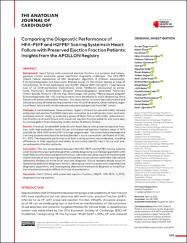Comparing the Diagnostic Performance of HFA-PEFF and H2FPEF Scoring Systems in Heart Failure with Preserved Ejection Fraction Patients: Insights from the APOLLON Registry

Göster/
Tarih
2023Yazar
Özlek, BülentÇil, Cem
Çelik, Oğuzhan
Başaran, Özcan
Doğan, Volkan
Biteker, Murat
Mert, Burbet Özge
Üst veri
Tüm öğe kaydını gösterKünye
Mert GÖ, Özlek B, Özlek E, et al. Comparing the diagnostic performance of HFA-PEFF and H2FPEF scoring systems in heart failure with preserved ejection fraction patients: Insights from the APOLLON registry. Anatol J Cardiol. 2023;27(9):539-548.Özet
Background: Heart failure with preserved ejection fraction is a complex and heterogeneous clinical syndrome, poses significant diagnostic challenges. The HFA-PEFF [Heart Failure Association of ESC diagnostic algorithm, P (Pretest Assessment), E (Echocardiographic and Natriuretic Peptide score), F1 (Functional testing in Case of Uncertainty), F2 (Final Aetiology)] and H2FPEF [Heavy (BMI>30 kg/m2), Hypertensive (use of ≥2 antihypertensive medications), atrial Fibrillation (paroxysmal or persistent), Pulmonary hypertension (Doppler Echocardiographic estimated Pulmonary Artery Systolic Pressure >35 mm Hg), Elderly (age >60 years), Filling pressure (Doppler Echocardiographic E/e' >9)] scoring systems were developed to aid in diagnosing heart failure with preserved ejection fraction. This study aimed to assess the concordance and clinical accuracy of these scoring systems in the 'A comPrehensive, ObservationaL registry of heart faiLure with mildly reduced and preserved ejection fractiON' cohort.
Methods: A comPrehensive, ObservationaL registry of heart faiLure with mildly reduced and preserved ejection fractiON study was conducted as a multicenter, cross-sectional, and observational study; to evaluate a group of Heart failure with mildly reduced ejection fraction and heart failure with preserved ejection fraction patients who were seen by cardiologists in 13 participating centers across 12 cities in Türkiye.
Results: The study enrolled 819 patients with heart failure with preserved ejection fraction, with high probability heart failure with preserved ejection fraction rates of 40% and 26% for HFA-PEFF and H2FPEF scorings, respectively. The concordance between the 2 scoring systems was found to be low (Kendall's taub correlation coefficient of 0.242, P < .001). The diagnostic performance of both scoring systems was evaluated, revealing differences in their approach and ability to accurately identify heart failure with preserved ejection fraction patients.
Conclusion: The low concordance between the HFA-PEFF and H2FPEF scoring systems underscores the ongoing challenge of accurately diagnosing and managing patients with heart failure with preserved ejection fraction. Clinicians should be aware of the strengths and limitations of each scoring system and use them in conjunction with other clinical and laboratory findings to arrive at an accurate diagnosis. Future research should focus on identifying additional diagnostic factors, developing more accurate and comprehensive diagnostic algorithms, and investigating alternative methods of diagnosis or stratification of patients based on different clinical characteristics.
Kaynak
THE ANATOLIAN JOURNAL OF CARDIOLOGYCilt
27Sayı
9Bağlantı
https://jag.journalagent.com/anatoljcardiol/pdfs/AJC-36177-ORIGINAL_INVESTIGATION-MERT.pdfhttps://hdl.handle.net/20.500.12809/10934

















